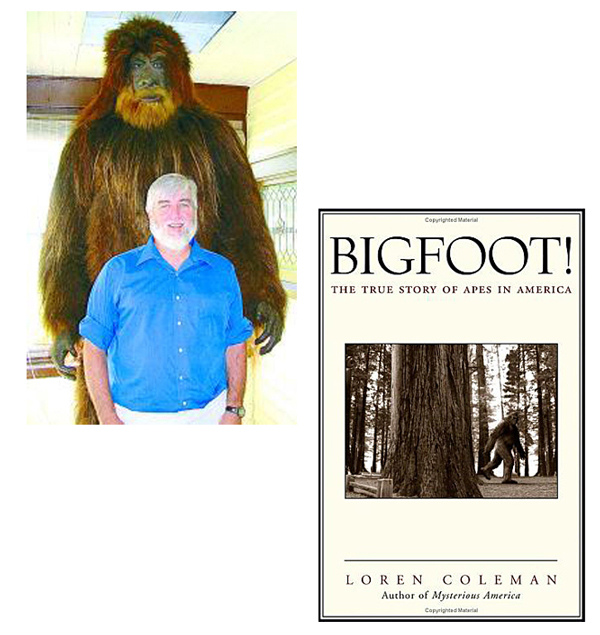Wednesday, October 26, 2005
Renowned cryptozoologist got his start at SIUC
By Marleen Shepherd
Southern Illinoisan
Loren Coleman has the Abominable Snowman to thank for his SIUC degree and successful career. In 1960, the Decatur youth caught a campy movie featuring the legendary Himalayan hominid and came back to school the next day with a lot of questions for his teachers.
“They said, ‘Don’t waste your time. It’s not true,’ which of course prompted me into reading everything I could about them,” said Coleman, now considered one of the world’s leading cryptozoologists – scientists who study rumored, mythological or extinct animals that are presumed to exist but for which there is no conclusive proof.
At only 12 years old, Coleman began absorbing every book he could on the subject, attending academic conferences and corresponding with more than 400 scientists, authors and amateur monster-hunters.
His journey of discovery led him to SIUC folklorist John W. Allen, whose 1963 book “Legends & Lore of Southern Illinois,” is now considered the Bible for the area’s celebrated storytelling.
Allen recounted descriptions by Southern Illinoisans and Kentuckians of the “little red men of the woods.”
The creatures are described as 4-feet-tall and hairy with human-like faces. They stand upright but are also able go to all fours like an ape. They are commonly reported throughout the American South in swampy areas and are known as swamp apes, skunk apes or napes, and monkey men.
A Mount Vernon resident told Allen he struck one of these mini-Bigfoots, known to Southern Illinoisans as Boogers, over the head with a rifle.
“(Allen) collected them as folklore,” Coleman said. “I was interested in them as actual cases of cryptozoology.”
Coleman arrived at SIUC in 1965 as an anthropology major and zoology minor to study Boogers as well as other mysterious animals of the area.
“I found SIU extremely open-minded about this,” Coleman said. “There was a lively intellectual atmosphere there that let me do what I needed to do.”
Coleman documented sightings and conducted field work knee-deep in Southern Illinois swamps. He went on to travel the world doing the same.
The result is more than 30 books, many of which make mention of central and Southern Illinois, including the classic 1983 “Mysterious America.” Coleman is a frequent guest of radio programs such as the paranormally friendly “Coast to Coast AM,” and has also appeared on National Public Radio’s “All Things Considered.”
Coleman is a consultant on several television shows including “In Search Of,” “Ancient Mysteries” and “Unsolved Mysteries.” During 2002, he was featured in “Search for the Mothman,” available on the DVD of the movie “The Mothman Prophecies.” He also served as the Screen Gems’ national and international publicity spokesperson for the movie.
This week Coleman is celebrating the first-ever Creature Appreciation Week, sponsored by the Wizards of the Coast’s Duel Masters trading card game, for which Coleman is also a consultant. Coleman says children’s interest in these creatures is often a gateway to education in the sciences.
“I get 500 e-mails a day from kids 7 and 8 and up through college who are interested in monsters. I tell them to stay in school and follow their passions.”
Coleman, now a film professor at the University of Southern Maine, encourages those hot and bothered by Bigfoot to study zoology and those loony for Loch Ness Monster to pursue marine biology.
He hears from parents who are thrilled that their reading-resistant kids are willing to sound out the names of the monsters on trading cards and in Coleman’s “Cryptozoology A to Z: The Encyclopedia of Loch Monsters, Sasquatch, Chupacabras, and Other Authentic Mysteries of Nature.”
Coleman now lives in Portland, Maine, where he created the International Cryptozoology Museum in 2003.
Creatures he has chased in Southern Illinois include the Murphysboro Mud Monster and black panthers, which have been sighted since the turn of the last century in the Shawnee National Forest and Crab Orchard areas.
Other animals in regional folklore include giant snakes and turtles, sea serpents of the Mississippi River and thunderbirds, flying mammals as large small airplanes. Illinois is considered a hotspot for cryptids, or the hypothetical critters Coleman chases.
“In the mid ’70s, Illinois had the most creature reports east of the Rockies,” Coleman said. He believes this is because SIUC professors and students, and area residents, actively related sightings. In addition, the long state of Illinois stretches from a dense urban area in the north to the plains in the middle to the swamps and forest of the south.
“There’s a wide variety of biohabitat,” he said.
While Coleman said he does not have a reason to believe in all of the creatures about which he compiles evidence, he does expect Bigfoot to be confirmed as reality.
“I think it’s pretty credible. I’ve talked to police officers in Alabama who found prints that matched those found by conservationists in Florida and game wardens in Illinois,” he said of a type of footprint that indicates a large side-attached big toe. “Most people who put fake Bigfoot prints make it look like a giant human foot. All these people finding the same large footprint tells me there’s something going on there that’s beyond fakery.”
For those skeptical of cryptozoology, Coleman points to the many animal discoveries once rumored to be myth. Among these are mountain gorillas, the megamouth shark, the coelacanth (a six-foot-long, walking fish), and most recently, the ivory-billed woodpecker.
“In Brazil, they’ve found a new monkey every year during the last decade,” Coleman said. Once a discovery is made, traditional science takes over and cryptozoology moves on to the next mystery. Coleman believes about 80 percent of the reports he investigates are fraudulent or the result of human error or imagination.
“That left me with 20 percent of the cases that were unknown and that’s what’s exciting.”
